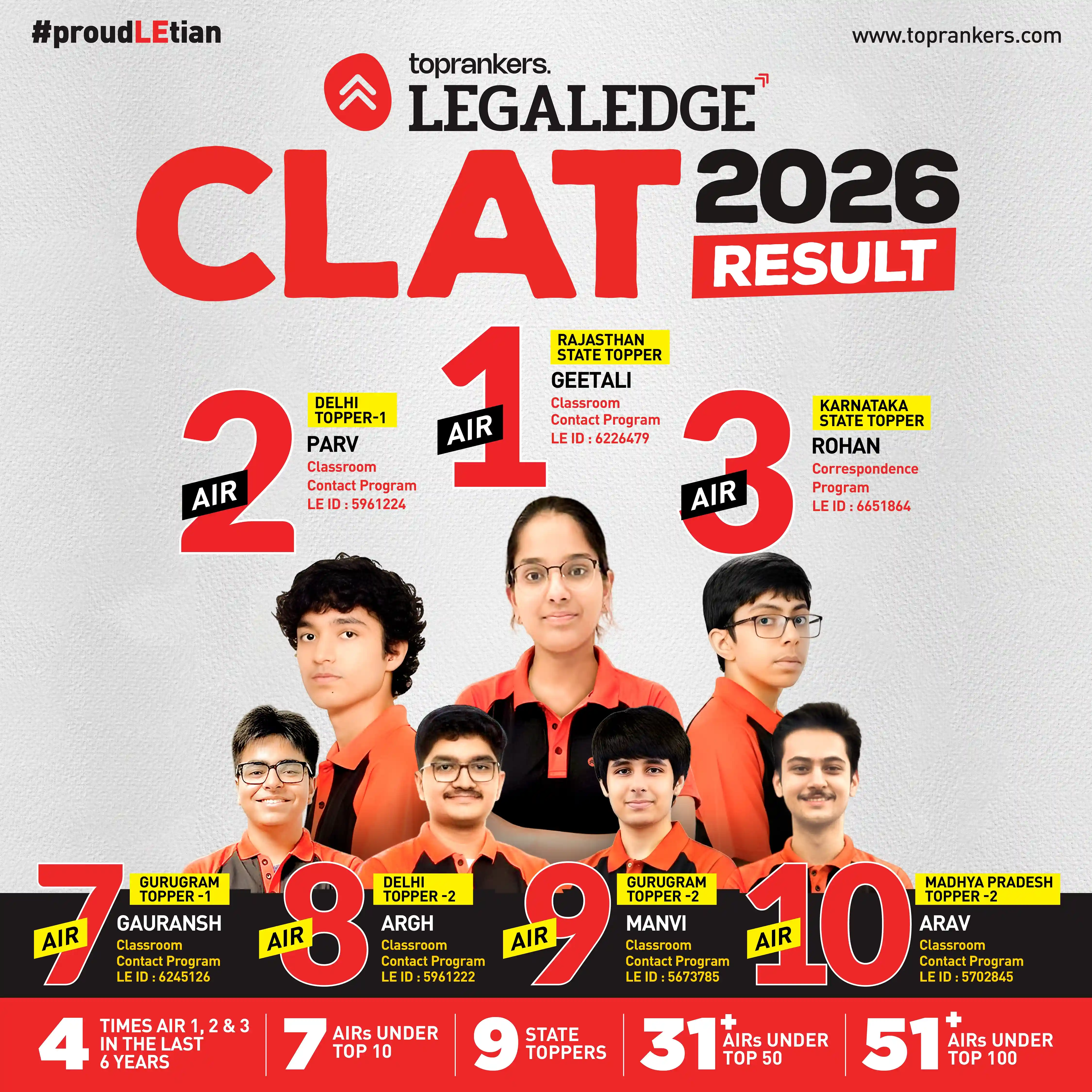CLAT Legal Reasoning Preparation Tips 2027: Expert Tips, Free Study Material & Must-Know Strategies
December 26, 2025
Reader's Digest: Are you wondering how to sharpen your CLAT legal reasoning skills? Check out these top CLAT Legal Reasoning preparation tips and boost your score!
Legal Reasoning for CLAT 2027: Highlights
- The legal reasoning section assesses your interest in law and tests your ability to comprehend, interpret and apply legal principles and facts.
- This section consists of passages based on hypothetical scenarios or factual events followed by a series of questions.
- This section's weightage in the CLAT paper is 25%, with approximately 28-32 questions.
- Each question carries one mark with a negative marking of 0.25 for every wrong answer.
- In case of a tie, aspirants with a higher score in the Legal Reasoning section will be given first preference. This denotes the significance of CLAT Legal Reasoning in your ranking, which ultimately determines the NLU you will study at!
CLAT Legal Reasoning Preparation Tips 2027: A Complete Guide
As the Consortium developed a new CLAT Exam Pattern, you must approach the legal reasoning section differently because the passages must be comprehended to look for facts and applicable rules.
The following are some tips you can follow to enhance your CLAT Legal Reasoning Preparation 2027:
- The legal reasoning section can be solved by applying analytical and comprehension strategies. It tests your ability to read and understand what has been written and apply it to the questions asked.
- It is not just reading comprehension but also application.
- Conceptual clarity of basic theories of static legal reasoning topics and a basic understanding of Current Legal Knowledge is advisable.
- Reading the passage information as a whole without applying any extra knowledge will guide you towards the most accurate answer.
- Consistently practising topic/sectional/mock tests, reviewing the results, and analysing your mistakes will improve your performance in this section.
- Ensure you learn to speed read and not skim for this section.
CLAT Legal Reasoning Preparation Tips 2027: Focus on Important Topics
The Legal Reasoning section is estimated to have 28-32 questions. Therefore, it is crucial to focus more on this section.
Before starting your preparation, it is essential to have a detailed understanding of CLAT Syllabus 2027, as this will help you ascertain and understand the important topics from the exam point of view.
CLAT Legal Reasoning Preparation Tips to Improve Time Management Skills
As the competition for the CLAT exam is increasing exponentially, you must put your maximum effort into the exam to pass with flying colours.
Effective time management is vital to securing a good rank. It will also help you boost your confidence, set priorities, and reduce stress levels.
You can follow the CLAT Time Management Tips to enhance your legal reasoning preparation.
- Step 1: You must allocate a few hours daily or alternate days for the legal reasoning section.
- Step 2: Get your required study material
- Step 3: Make a timetable for each topic and try to complete all the issues within the fixed time.
- Step 4: Set aside the time-consuming topics and revise them at the end of the day.
- Step 5: Improve your legal vocabulary by understanding legal jargon, legal maxims and phrases.
- Step 6: Try to attempt more and more questions from the Topic/sectional and mock tests regularly to know the difficulty level and the type of questions asked from the legal reasoning section
- Step 7: Use the order like reading the passage-questions-options.
- Step 8: Practice mock tests to improve your speed and accuracy.
CLAT Legal Aptitude Preparation Tips 2027: Step-by-Step Strategy
The following are some of the best CLAT Legal Reasoning Preparation Tips to enhance your legal preparation and crack the CLAT exam on the first attempt:
- You must clear your concepts first and then apply them while attempting to answer questions.
- Focus on improving your reading skills.
- Read legal theory: Law of Torts, Law of Contracts, Constitutional Law, Criminal Laws, Miscellaneous Laws, etc.
- Prepare well for legal terminologies, legal maxims, and legal phrases.
- Every 15 days, do your revision to remember whatever you have studied.
- Follow the order, such as passage-question-options, to get the most accurate option.
- Solve the previous years' question papers and mock tests as soon as possible and work on your weaker areas.
Read more: Short tricks to solve para jumble questions in CLAT
How to Answer CLAT Legal Reasoning Questions?
Here are a few CLAT Legal Reasoning Preparation Tips you can follow to quickly answer all the questions asked in the Legal reasoning section:
- Make sure to read the passage and the questions thoroughly to identify the principles.
- You only have a little time to spend reading questions again and again. So, make sure you read it focusing on the first time, our expert Harsh emphasis.
- After a thorough reading, try to relate the facts drawn with the question and analyze if they fully support/ justify the argument without any assumptions.
- Please pay attention to the small details and identify all the principles and roles in the passage.
- Beware of the minor tweaks in the statements or questions. Attention to detail is key here.
- Try to keep your assumptions outside the principle facts and stick to the theories that the principle is always correct.
- Save time on a single question if you cannot identify the correct answer.
CLAT Legal Reasoning Preparation Tips: Choose the Best Books
The following CLAT Books can help prepare the legal reasoning section:
- Complete CLAT Common Law Admission Test Companion by Harsh Gagrani and Karan Mehta
- LA/LR Legal Awareness and Legal Reasoning by A.P. Bhardwaj
- CLAT Entrance Exam Guide Paperback by LearnX
- Legal Reasoning for CLAT, AILET, SLAT & Other Law Entrance Exams with Previous Year Questions 3rd Edition | Legal Aptitude/ Awareness for 2023 Law Exams by Disha Experts
CLAT Legal Reasoning Preparation Tips to Score 25+ Marks
- Understand the legal principles.
- Learn to apply the facts in the situations and arguments.
- Practice shortcut techniques, but we suggest not completely relying on them. Instead, go through them for knowledge and new ideas.
- Good reading speed is essential to crack this section. Therefore, it is recommended to read a lot.
- Try reading law magazines and current legal knowledge topics from various sources to gain more legal perspectives.
- Practice asking more and more questions from previous years' papers.
- Solve as many mock tests as possible to build your confidence.
- While solving the passages, read the passages line-by-line and word-by-word while underlining the keywords without applying extra knowledge to reach the most accurate option.
CLAT Legal Reasoning Preparation Tips 2027: Boost Your Marks by Solving Mocks
- Solving CLAT Mock Tests would help improve your speed and accuracy on the day of your exam and help you score good marks.
- Also, it will help you know the difficulty level of the paper and the type of questions asked in the exam.
- With the help of mock tests, you can test your preparation level and improve in weak areas.
- Practising mock tests will help improve your time-management skills and confidence levels.
- The most important part is analysing the mocks and the mistakes you make in legal, which is the lengthiest.
CLAT Legal Reasoning Preparation Tips 2027: Last Week's Preparation Strategy
A proper preparation plan for last week is more critical than a year-long preparation. It would be best to focus only on the following CLAT Legal Aptitude Preparation Tips:
- Solving Previous Year's CLAT Question Papers is the most important step, as this will help you improve your time management and problem-solving skills.
- Try to solve at least two to three mock tests per week.
- Revise all the essential formulas daily.
- Stay positive and calm.
- Take care of your health.
Conclusion
In conclusion, effective preparation for the CLAT Legal Reasoning section is crucial for success in the exam. Following the right strategies and techniques can enhance legal reasoning skills and boost overall performance.
Here are the key takeaways to remember from these CLAT Legal Reasoning Preparation Tips:
- Understand the structure and syllabus of the CLAT Legal Reasoning section.
- Develop analytical and logical reasoning skills.
- Build a strong foundation in legal knowledge.
- Practice legal reasoning questions and case analysis.
- Enhance legal vocabulary and comprehension.
- Utilize previous year's papers and mock tests for practice.
- Manage your time effectively during the exam.
- Seek guidance from experts and coaching resources.
- Create a personalized study plan and revision schedule.
By implementing these tips and dedicating consistent effort, you can confidently approach the CLAT Legal Aptitude section and improve your chances of success in the CLAT exam.
Frequently Asked Questions
What is the purpose of the Legal Reasoning section in the CLAT exam?

What topics are covered in the passages of the Official CLAT Legal Reasoning Sample Paper?

How can a general awareness of contemporary legal and moral issues benefit me in the Legal Reasoning section?

How to increase marks in CLAT Legal Reasoning section?

How to answer CLAT Legal Reasoning Questions easily?

Does Consortium release the Legal Reasoning Sample Paper every year?









SHARE